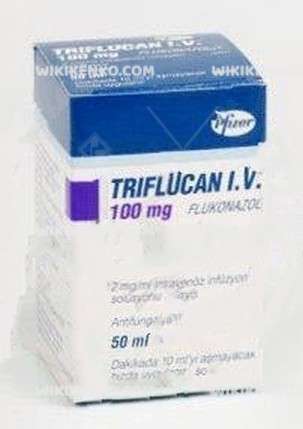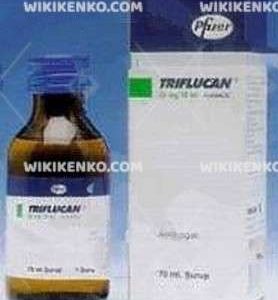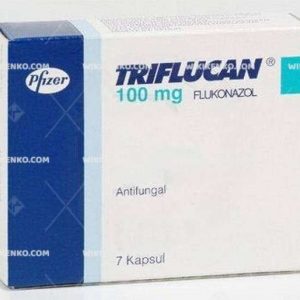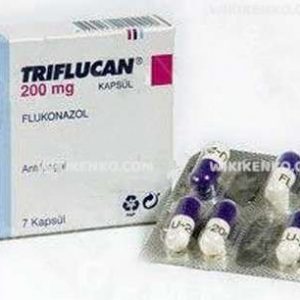Triflucan Iv Infusion Solution
We are excited to provide you with a comprehensive overview of Triflucan IV Infusion Solution, a crucial medication used in the treatment of various fungal infections. In this article, we’ll delve into the composition, indications, dosages, and more, equipping you with the knowledge to make informed decisions about your health.
| Dosage form | |
|---|---|
| Pack size | |
| Potency | 2 Mg/Ml (50Ml) 1X50Ml |
| Manufacturer | |
| Origin | |
| Generic Name (Ingredient) | Fluconazole 2 Mg |
Assuming your emergency circumstances for this product, visit Urgent Quotation page. Besides, for any pharmaceutical questions, please ask us in the comments section.
Description
Composition and Pharmaceutical Form
Triflucan IV Infusion Solution contains 2 mg of fluconazole per milliliter. Notably, it also includes 9 mg of sodium chloride (equivalent to 0.154 mmol sodium) per milliliter. The solution is clear, colorless, and free from visible particles, making it a suitable pharmaceutical form for intravenous infusion.
Clinical Indications
Adults
Triflucan IV Infusion Solution is indicated for the treatment of various fungal infections in adults, including:
- Cryptococcal meningitis
- Coccidioidomycosis
- Invasive candidiasis
- Mucosal candidiasis (including oropharyngeal and esophageal candidiasis)
- Chronic oral atrophic candidiasis (denture sore mouth)
Additionally, Triflucan is used for prophylaxis in the following conditions:
- Relapse of cryptococcal meningitis
- Relapse of oropharyngeal or esophageal candidiasis in HIV-infected patients
- Candidal infections in patients with prolonged neutropenia
Pediatrics (Ages 0–17)
Triflucan IV Infusion Solution is also indicated for the treatment of fungal infections in pediatric patients, including:
- Mucosal candidiasis (oropharyngeal, esophageal)
- Invasive candidiasis
- Cryptococcal meningitis
For prophylaxis, Triflucan is used to prevent the relapse of cryptococcal meningitis in high-risk children.
Dosage and Administration
Posology
The dosage of Triflucan IV Infusion Solution is based on the nature and severity of the fungal infection. Treatment duration should continue until clinical parameters or lab tests indicate the resolution of the active infection.
Adults
For the treatment of cryptococcosis, the recommended dosage is:
- Loading dose: 400 mg on Day 1
- Subsequent dose: 200–400 mg once daily
- Duration: Usually 6–8 weeks (can increase to 800 mg in life-threatening infections)
Triflucan is also used for maintenance therapy to prevent the relapse of cryptococcal meningitis in high-risk patients.
Pediatrics
The dosage for pediatric patients is similar to that of adults, adjusted for age and weight.
Method of Administration
Triflucan IV Infusion Solution is administered via intravenous infusion at a rate not exceeding 10 ml/minute. The solution is formulated in a sodium chloride 9 mg/ml (0.9%) solution for infusion.
Common Side Effects of Triflucan
Triflucan (fluconazole) is generally well-tolerated, but like any medication, it can cause side effects. Here are the common side effects associated with Triflucan:
| Side Effect | Description |
|---|---|
| Nausea | Feeling queasy or an urge to vomit |
| Stomach Pain | Discomfort or ache in the abdominal area |
| Diarrhea | Frequent, loose bowel movements |
| Upset Stomach | General discomfort or uneasiness in the stomach |
| Headache | Aching or pain in the head |
| Dizziness | Feeling lightheaded or unsteady |
| Changes in Taste | Alterations in how things taste |
It’s important to note that individual responses may vary, and some serious side effects, such as liver problems, skin rash, and heart rhythm changes, are possible but less common.
Time to Improvement with Triflucan
The time it takes to see improvement after starting Triflucan can vary depending on the specific infection and the individual’s response to the medication.
Mild, Uncomplicated Infections
For mild, uncomplicated fungal infections, a single 150 mg dose of fluconazole is often prescribed. Improvement in symptoms is typically seen within one to three days. If symptoms persist or the infection is severe, fluconazole may be given as three consecutive doses spaced three days apart, with symptoms improving within one to two weeks. In some cases, fluconazole may be prescribed for daily use for ten to fourteen days or even continued once per week for six months.
Maintenance Therapy
For recurrent vulvovaginal candidiasis, a dosage of 100 to 200 mg orally once a week is recommended for six months.
Steady-State Concentrations
Steady-state concentrations of fluconazole are reached within 5 to 10 days following oral doses. A loading dose (on Day 1) of twice the usual daily dose helps achieve plasma concentrations close to steady-state by the second day.Remember that individual responses may vary, and it’s essential to consult your healthcare provider for personalized advice. If symptoms persist or worsen, seek medical attention promptly.
Triflucan and Nail Fungus
Triflucan (fluconazole) is not typically the first-line treatment for nail fungus, also known as onychomycosis. However, it may be used in some cases, and it’s important to understand the diagnosis and treatment options for this condition.
Diagnosis and Treatment of Nail Fungus
To diagnose nail fungus, your healthcare provider will examine your nails and may take nail clippings or scrape debris from under the nail for laboratory analysis.Common treatment options for nail fungus include:
Oral Antifungal Medications
- Fluconazole (Triflucan): Although not FDA-approved specifically for toenail fungus, fluconazole is sometimes used off-label. It’s typically taken once a week for at least 3 to 6 months.
- Terbinafine and Itraconazole are other oral antifungals commonly prescribed.
Topical Medications
- Antifungal Nail Lacquer or Topical Solution: Applied directly to the affected nails.
Self-Care Practices
- Keep feet dry and clean.
- Avoid using old shoes.
- Use socks that absorb sweat.
- Consider antifungal foot powder in shoes and socks.
- Wear clean shoes of the right size.
Effectiveness and Duration
Oral antifungal medications, including fluconazole, help a new nail grow free of infection, gradually replacing the infected part. Maintenance therapy may be necessary to prevent relapse. Topical medications may be appropriate for milder infections or if oral options are not feasible.
Using Triflucan Alongside Topical Treatments
While Triflucan (fluconazole) is primarily administered orally, there are considerations regarding its use alongside topical antifungal treatments.
Combining Oral and Topical Treatments
In some cases, healthcare providers may recommend using both oral and topical antifungal treatments simultaneously. This approach aims to enhance the effectiveness of the treatment by targeting the infection from different angles. However, individual responses can vary, and the decision depends on the specific infection, severity, and patient factors.
Topical Antifungal Treatments
Topical antifungal treatments, such as antifungal nail lacquer or topical solutions, are commonly used for mild to moderate nail fungus. They are applied directly to the affected nails. Topical treatments may be less effective for severe or deep infections.
Fluconazole (Triflucan)
Fluconazole is taken orally and treats infections caused by fungus throughout the body, including the mouth, throat, lungs, and blood. It is not specifically FDA-approved for toenail fungus but may be used off-label. The usual dosage for toenail fungus is once a week for 3 to 6 months.
Safety and Interactions
Certain drugs can interact with fluconazole, so it’s essential to inform your healthcare provider about all medications you use. Discuss any potential interactions between oral fluconazole and topical treatments with your doctor.Always consult your healthcare provider before combining different antifungal treatments. They can provide personalized advice based on your specific condition, medical history, and other factors.
Triflucan IV Infusion Solution Interactions
Triflucan IV Infusion Solution (fluconazole) is an antifungal medication used for intravenous administration. Let’s explore its interactions and relevant information.
Description and Composition
Fluconazole is a synthetic triazole antifungal agent. The intravenous solution contains 2 mg of fluconazole and 9 mg of sodium chloride or 56 mg of dextrose, hydrous per milliliter. The pH ranges from 4.0 to 8.0 in the sodium chloride diluent and from 3.5 to 6.5 in the dextrose diluent.
Clinical Use
Triflucan IV Infusion Solution is indicated for the treatment of various fungal infections and the prevention of candidiasis in patients undergoing bone marrow transplants or receiving cancer/radiation treatment. It is also used in children on life support (extracorporeal membrane oxygenation, ECMO).
Mechanism of Action
Fluconazole kills or prevents the growth of fungus or yeast.
Interactions
Triflucan IV Infusion Solution may interact with certain medications, leading to decreased adrenal gland hormones or liver problems. It’s essential to consult your healthcare provider regarding specific interactions and personalized advice.
Dietary Considerations During Triflucan Treatment
When taking Triflucan (fluconazole), there are a few dietary considerations to keep in mind:
General Guidelines
- Take with or without Food: You can take Triflucan with or without food.
- Avoid Alcohol: It’s advisable to avoid alcohol while on Triflucan, as it may interact with the medication and increase the risk of side effects.
- Stay Hydrated: Maintain good hydration during treatment.
Specific Dietary Restrictions
- Sucrose Content: The liquid form of Diflucan (fluconazole) contains sucrose. If you have difficulty digesting sugars, discuss this with your doctor before taking Diflucan oral suspension.
- Potassium Levels: If you have low levels of potassium in your blood, consult your healthcare provider. Triflucan does not directly affect potassium levels, but individual health conditions may require monitoring.
Drug Interactions
Certain foods or dietary supplements can interact with medications. Always inform your healthcare provider about all medicines, vitamins, and herbal products you use, as some drugs should not be used together with fluconazole. Your doctor may adjust your treatment plan based on other medications you are taking.
Remember that individual responses may vary, and it’s essential to follow your doctor’s advice. If you have specific dietary concerns, discuss them with your healthcare provider.
Conclusion
In this comprehensive guide, we have explored the key aspects of Triflucan IV Infusion Solution, including its composition, clinical indications, dosage and administration, common side effects, and interactions. By understanding the nuances of this antifungal medication, healthcare professionals and patients can make informed decisions and optimize the management of fungal infections.
We hope this article has provided you with the necessary knowledge to navigate the complexities of Triflucan and its role in the treatment of various fungal conditions.
Use the form below to report an error
Please answer the questions as thoroughly and accurately as possible. Your answers will help us better understand what kind of mistakes happen, why and where they happen, and in the end the purpose is to build a better archive to guide researchers and professionals around the world.
The information on this page is not intended to be a substitute for professional medical advice, diagnosis, or treatment. always seek the advice for your physician or another qualified health provider with any questions you may have regarding a medical condition. Always remember to
- Ask your own doctor for medical advice.
- Names, brands, and dosage may differ between countries.
- When not feeling well, or experiencing side effects always contact your own doctor.
Cyberchondria
The truth is that when we’re sick, or worried about getting sick, the internet won’t help.
According to Wikipedia, cyberchondria is a mental disorder consisting in the desire to independently make a diagnosis based on the symptoms of diseases described on Internet sites.
Why you can't look for symptoms on the Internet
If diagnoses could be made simply from a textbook or an article on a website, we would all be doctors and treat ourselves. Nothing can replace the experience and knowledge of specially trained people. As in any field, in medicine there are unscrupulous specialists, differences of opinion, inaccurate diagnoses and incorrect test results.






Reviews
There are no reviews yet.